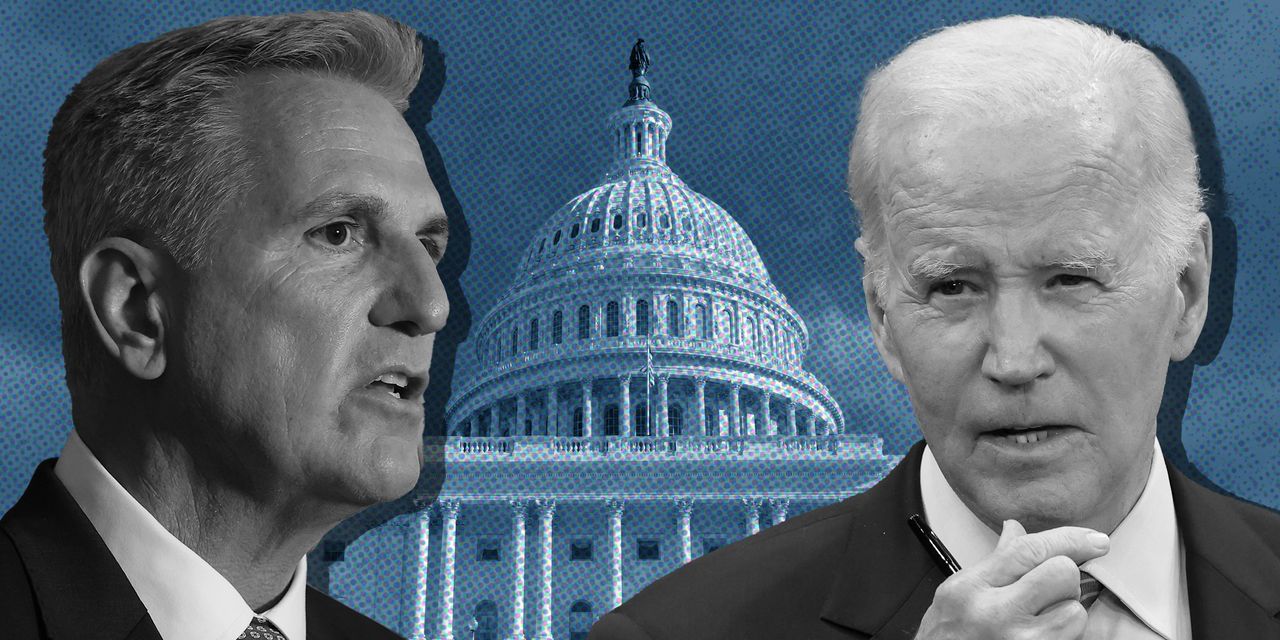Apologies in advance, but the now-clichéd description actually is true: We are partying like it’s 1999, at least as far as stocks are concerned.
Once again, the equity market has been powered by a relative handful of technology stocks that have soared on their potential to fundamentally change the world. Not since 1999 has the disparity between the conventional, capitalization-weighted
S&P 500
(dominated by the biggest half-dozen megacap techs) and the equal-weighed alternative measure of those 500 stocks been so egregious.
By Deutsche Bank’s calculation, from the beginning of 2023 through Thursday, the S&P 500 was up 8.1%, versus a 1.2% decline in the equal-weighted S&P, a difference of 9.3 percentage points. For all of 1999, the spread between the two measures was also 9.3 percentage points, which was exceeded only by 1998’s 16.3 percentage-point spread.
The market’s concentration of strength in just a few highfliers recalls the Nifty Fifty blue-chip era, according to Doug Kass, longtime friend of this column and head of Seabreeze Partners Management in Palm Beach, Fla. That preceded the brutal bear market of 1973-74.
Moreover, the current market violates one of the famous rules of investing from the legendary Bob Farrell, the former head of Merrill Lynch’s market analysis, whom Kass often cites: “Markets are strongest when they are broad and weakest when they narrow to a handful of blue-chip names.”
Monetary conditions also recall the end of the past century. Then, the Federal Reserve was tightening policy, raising its federal-funds target rate from around 4.75% to 6.50% by mid-2000. In the past year-plus, the central bank has sharply lifted the fed-funds target rate from near zero to 5%-5.25%, while also reducing its balance sheet to tighten policy further.
The increase in interest rates has made stocks more expensive relative to bonds than they’ve been since October 2007, just before the 2008-09 financial crisis, Kass adds. Moreover, as the Fed has lifted rates, estimates of 2023 S&P 500 earnings have come down by more than 10%, he writes in an email.
One factor lifting equities, ironically, has been the debt-ceiling impasse, which mercifully seemed close to resolution as we headed into the Memorial Day weekend. While Uncle Sam hasn’t been able to increase borrowings, he’s been emptying his piggy bank, which injects liquidity into the financial system. Raising the debt ceiling would let the federal government issue billions in Treasury bills to refill its coffers, which will drain liquidity. (For more on this, see the Trader column,s “The Nasdaq Has Been Crushing The Dow. Can It Last?“)
At the same time, expectations about Fed rate changes have undergone a major reversal. Further increases now are expected at the coming meetings of the Federal Open Market Committee; previously, the Street had anticipated no hikes. Indeed, its previous hopes for cuts have faded.
According to the CME FedWatch site, the probability of a quarter-point increase at the June 13-14 FOMC meeting has risen sharply, to 66.5%, as of Friday, from just 17.4% just a week earlier. The probability of at least one boost at the July 25-26 meeting was 78.9%, up from less than 20% a week earlier. At the end of April, the market actually saw a 43% chance of a rate cut.
Improving economic conditions, along with persistent inflation and waning concerns about more failures among regional banks, have altered rate expectations. That is seen most clearly in the two-year Treasury note’s yield, which fell from over 5% just before the collapse of Silicon Valley Bank in March to 3.80% in early May, before rebounding to 4.56% Friday.
Key data reports—especially the May employment release due Friday—should take center stage during the coming holiday-shortened week. The consensus guess among economists is for another solid increase in nonfarm payrolls: 190,000. At the same time, inflation has shown little signs of easing. Fed Chairman Jerome Powell’s favorite measure of price pressures—the core services personal consumption deflator, excluding housing—has risen at a 4.3% clip since January and 4.5% in the past 12 months, according to Brean Capital.
With inflation still far above the Fed’s 2% target, unemployment at historic lows, and the major stock averages near their peaks, there’s little reason not to expect rate increases. The party didn’t end in 1999, but it did end eventually.
Write to Randall W. Forsyth at [email protected]
Read the full article here


